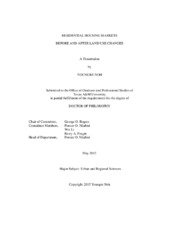| dc.contributor.advisor | Rogers, George O. | |
| dc.creator | Noh, Youngre | |
| dc.date.accessioned | 2015-09-21T18:13:19Z | |
| dc.date.available | 2017-05-01T05:35:46Z | |
| dc.date.created | 2015-05 | |
| dc.date.issued | 2015-05-13 | |
| dc.date.submitted | May 2015 | |
| dc.identifier.uri | https://hdl.handle.net/1969.1/155269 | |
| dc.description.abstract | This study expands the existing literature on impact of environmental amenities and disamenities on the value of single family housing by temporally and spatially examining changes in the effect of nature and industry. The study area is bounded by a forest, a portion of which has been designated as a nature preserve and another portion had been sites for oil wells until 1993 and have transformed into a nature preserve. Using a comprehensive dataset of market price from sales transactions collected over a period of twenty-eight years, this study examined the changes in the impact of nature preserve and industrial site in the City of Whittier, CA before and after the conversion. The data was collected from 1986, when all oil wells sites were considered active, until the most recent sales transaction data in 2013. This study compares the impact in a series of fourteen two year periods. The 28 year study period includes four periods before the conversion and ten periods after the conversion. This structure allows for before-and-after comparison of the impact of the conversion on itself and near amenities in regards to housing sales prices. The spatial hedonic models in series of longitudinal analyses assisted to compare the effects of transformation and examine the recovery process over time across space.
The result revealed that it took 10 years for the former oil wells site to recover its positive association to near single family homes as an amenity. There was an initial increase of positive association between the site and the sales price of single family houses upon the conversion. In contrast, positive association between the nature preserve and nearby properties had constantly decreased since the conversion. After 10 years from the conversion, the positive impact of the former oil well sites surpassed the positive impact of the neighboring never-developed nature preserve. Recovery of use value and expectation of the residents accounts for the initial increase and recovery of non-use value and changes in the residents’ perception accounts for the later increase, which took 10 years after the conversion. | en |
| dc.format.mimetype | application/pdf | |
| dc.language.iso | en | |
| dc.subject | spatial hedonic models | en |
| dc.subject | nature preserve | en |
| dc.subject | industrial site | en |
| dc.subject | environmental valuation | en |
| dc.subject | longitudinal analysis | en |
| dc.subject | oil wells | en |
| dc.title | Residential Housing Markets Before and After Land Use Changes | en |
| dc.type | Thesis | en |
| thesis.degree.department | Landscape Architecture and Urban Planning | en |
| thesis.degree.discipline | Urban and Regional Sciences | en |
| thesis.degree.grantor | Texas A & M University | en |
| thesis.degree.name | Doctor of Philosophy | en |
| thesis.degree.level | Doctoral | en |
| dc.contributor.committeeMember | Ndubisi, Forster O. | |
| dc.contributor.committeeMember | Li, Wei | |
| dc.contributor.committeeMember | Feagin, Rusty A. | |
| dc.type.material | text | en |
| dc.date.updated | 2015-09-21T18:13:19Z | |
| local.embargo.terms | 2017-05-01 | |
| local.etdauthor.orcid | 0000-0002-3595-0087 | |


